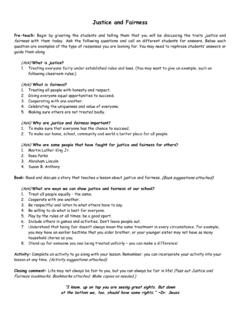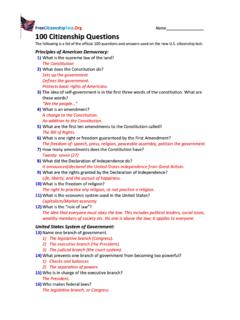Transcription of The Racial Caste System - Stanford University
1 Groups such as gays and Lesbians, atheists, andsometimes recent immigrant groups tend to be linkedby how others view intergroup attitudes and behaviors are associ-ated with each other in expected ways. Of particularnote is the connection between contact with other racialand ethnic groups and greater concern over intergrouprelations. More contact is associated with more feelingsof closeness, more perception of discrimination, moreperception of groups as lacking enough influence, moresupport for intergroup equality and integration, and lessnegative views of measures of attitudes toward and behaviorsconcerning intergroup relations show improvementduring the last decade, and this progress comes ontop of similar gains during the last half-century.
2 Forexample, feeling close to Blacks was an experiencereported by 38% of participants in 1996 and 56% in2005. Among Blacks, personal experiences of racialdiscrimination at work during the last month fell from21% in 1997 to 11% in 2005, and the judgment thatBlacks have too much influence dropped from 20% in1996 to 10% in 2005. The changes are more of theslow-and-steady type, rather than representing break-throughs or dramatic surges, but because they havegenerally been in the same direction over time,notable shifts have often is, however, much room for further the large increase in those perceiving a great dealof discrimination against Muslims (from 11% to 35%between 2000 and 2006, before and after theSeptember 11, 2001, terrorist attacks) indicates, eventscan intrude to stall or reverse improvements in inter-group W.
3 SmithSee alsoBrown v. Board of Education;Color Blindness;Contact Hypothesis; Discrimination; InterculturalCommunication; Interracial Friendships; MuslimAmericans; Plessy v. Ferguson; Prejudice; RacetalkFurther ReadingsSmith, Tom W. 1998. Intergroup Relations in ContemporaryAmerica: An Overview of Survey Research. InIntergroup Relations in the United States: ResearchPerspectives,edited by W. Winborne and R. Cohen. NewYork: National Conference of Christians and Jews (NCCJ). Smith, Tom W. 2000. Taking America s Pulse II: NCCJ s2000 Survey of Intergroup Relations in the United York: National Conference of Christians and Jews(NCCJ).
4 Smith, Tom W. 2006. Taking America s Pulse III: IntergroupRelations in Contemporary York: NationalConference of Christians and Jews (NCCJ).INTERMARRIAGEF amily systems reproduce race by insisting uponendogamy, or marriage within the group. Racial inter-marriage, the opposite of endogamy, tends to under-mine Racial barriers. In any society in which race isimportant, Racial intermarriage will be a focus oflegal, social, and political interest. The United Stateshas been a society deeply divided by race from itsbeginning, as a nation in which slavery was practiced,so the issue of intermarriage has always been impor-tant in the United States.
5 This entry describes the his-tory of policy on intermarriage and its wider Racial Caste SystemBefore the civil war, most Blacks in the United Stateswere slaves. Although there had always been somesexual relationships between White (male) slaveown-ers and Black (female) slaves, White society workeddiligently to make these relationships invisible. society adopted what was called the one-droprule, which meant that anyone with as much as onedrop of non-White blood could not be consideredWhite. By legal definition, if a White slave mastermade a Black slave pregnant, her child was Black(because of the one-drop rule ) and a slave as marriage was generally not possible betweenslaves (because slaves had no legal standing), andtherefore formal marriage between free Whites andslaves was irony of the one-drop rule was that it was cre-ated to clarify Racial distinctions, but the rule left Whiteracial status always vulnerable.
6 The discovery of somepreviously unknown brown or dark ancestor (or evenan ancestor who was remembered by someone as dark)would rob all descendants of their Whiteness and there-fore of their property and their 2/18/2008 4:12 PM Page 736 With the emancipation of theslaves at the end of the Civil War,White society was suddenly con-fronted with Blacks as legal equals,at least in theory. White elites pro-fessed a horror at the possibility ofsocial mixing on an equal footingwith Blacks, and the deepest horrorwas preserved for the most intimatetype of mixing, intermarriage.
7 In the1864 presidential election, while theCivil War was still raging, proslav-ery newspaper editors in New Yorkpromulgated a hoax implying thatAbraham lincoln and the abolitionistsin the North were secretly hoping tomarry Blacks to Whites on a massscale. The proslavery hoax coinedthe term miscegenationfor racialintermixing and intermarriage, andsuch was the fear of intermarriagethat White voters in the North hadlargely abandoned lincoln s reelec-tion campaign until battlefieldvictories ensured his feared Racial intermarriage for severalreasons.
8 First, a White person who married a Blackperson was throwing his or her lot in with Black soci-ety in more than just a symbolic way. Such a gesturewas sure to be a blow to the social standing of theWhite person s family (raising questions aboutwhether they were really White after all), so familiesworked diligently to ensure that their children under-stood that interracial marriage was taboo. Second,interracial marriage created the possibility that Blackdescendants could inherit property from White fami-lies. Third, 19th-century intellectual justifications forracial differences emphasized the theory that Blacksand Whites were different biological species, a theorythat implied that an interracial couple could not repro-duce, or that the offspring of a Black-White unionwould necessarily be weak of mind and there was plenty of evidence that Blacksand Whites had reproduced successfully.
9 The infor-mality of liaisons during slavery allowed that evi-dence to be marriages were such a threat to theracial order that in the aftermath of the Civil War,many states hurried to pass laws making interra-cial marriage illegal, and these laws were commonlyreferred to as antimiscegenation laws. The statelaws against interracial marriage varied in whichgroups were prohibited from marrying which othergroups, but every such law prohibited Blacks frommarrying in 20th-Century LawThe 20th century brought several changes that madeintermarriage more acceptable and common and thatundermined the Racial Caste System of the UnitedStates.
10 The first great Black migration North, aroundthe time of World War I, brought several millionBlacks into Northern states, which had never had lawsagainst Racial intermarriage, partly because theseNorthern states had never had many Black segregation grew in the North as Blackneighborhoods and ghettos grew, and as Whites foundways to limit their social exposure to intermarriage between Blacks and Whitesdid not begin to increase in the United States until afterIntermarriage 737 Interracial couple with their the 20th century, several changesoccurred that made intermarriage more acceptable and common, underminingthe Racial Caste System of the United States.













